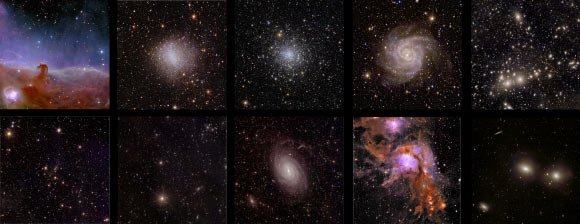ESA’s Euclid mission has released five new images that showcase the telescope’s ability to explore two large-scale cosmic mysteries: dark matter and dark energy. The images feature views of varying sizes — the star-forming region Messier 78, the spiral galaxy NGC 6744, galaxy clusters Abell 2390 and Abell 2764, and the Dorado galaxy group — and were taken shortly after Euclid’s launch in July 2023 as part of its early release observations program. These images accompany the mission’s first scientific data, also made public today, and 10 forthcoming science papers. Some of the science includes: new-born free-floating planet candidates, newly-identified extragalactic star clusters, new low-mass dwarf galaxies in a nearby cluster of galaxies, and the discovery of very distant bright galaxies.
These images were captured by ESA’s Euclid space telescope. Image credit: ESA / Euclid / Euclid Consortium / NASA / J.-C. Cuillandre, CEA Paris-Saclay / G. Anselmi.
Euclid — built and operated by ESA, with contributions from NASA — lifted off from Cape Canaveral Space Force Station in Florida on July 1, 2023.
By 2030, the mission will create a cosmic map that covers almost a third of the sky, using a field of view that is far wider that than the NASA/ESA Hubble Space Telescope and the NASA/ESA/CSA James Webb Space Telescope, which are designed to study smaller areas in finer detail.
Astronomers will then chart the presence of dark matter with higher precision than ever before. They can also use this map to study how dark energy’s strength has changed over time.
“Euclid is a unique, ground-breaking mission, and these are the first datasets to be made public — it’s an important milestone,” said Dr. Valeria Pettorino, ESA’s Euclid project scientist.
“The images and associated science findings are impressively diverse in terms of the objects and distances observed.”
“They include a variety of science applications, and yet represent a mere 24 hours of observations.”
“They give just a hint of what Euclid can do. We are looking forward to six more years of data to come!”
The full set of early observations targeted 17 astronomical objects, from nearby clouds of gas and dust to distant clusters of galaxies, ahead of Euclid’s main survey.
This survey aims to uncover the secrets of the dark cosmos and reveal how and why the Universe looks as it does today.
“Euclid intends to tackle the biggest open questions in cosmology. And these early observations clearly demonstrate that Euclid is more than up to the task,” Dr. Pettorino said.
Euclid will trace the hidden web-like foundations of the cosmos, map billions of galaxies across more than one-third of the sky, explore how our Universe formed and evolved over cosmic history, and study the most mysterious of its fundamental components: dark energy and dark matter.
The images obtained by Euclid are at least four times sharper than those we can take from ground-based telescopes.
They cover large patches of sky at unrivalled depth, looking far into the distant Universe using both visible and infrared light.
“It’s no exaggeration to say that the results we’re seeing from Euclid are unprecedented,” said Professor Carole Mundell, director of science at ESA.
“Euclid’s first images clearly illustrated the telescope’s vast potential to explore the dark Universe, and this second batch is no different.”
“The beauty of Euclid is that it covers large regions of the sky in great detail and depth, and can capture a wide range of different objects all in the same image — from faint to bright, from distant to nearby, from the most massive of galaxy clusters to small planets.”
“We get both a very detailed and very wide view all at once.”
“This amazing versatility has resulted in numerous new science results that, when combined with the results from Euclid’s surveying over the coming years, will significantly alter our understanding of the Universe.”
While visually stunning, the images are far more than beautiful snapshots; they reveal new physical properties of the Universe thanks to Euclid’s novel and unique observing capabilities.
These scientific secrets are detailed further in a number of accompanying papers released by the Euclid Collaboration, made available on arXiv.org, together with five key reference papers about the Euclid mission.
“Euclid demonstrates European excellence in frontier science and state-of-the-art technology, and showcases the importance of international collaboration,” said ESA Director General Dr. Josef Aschbacher.
“The mission is the result of many years of hard work from scientists, engineers and industry throughout Europe and from members of the Euclid scientific consortium around the world, all brought together by ESA.”
“They can be proud of this achievement — the results are no small feat for such an ambitious mission and such complex fundamental science.”
“Euclid is at the very beginning of its exciting journey to map the structure of the Universe.”
Discover more from CaveNews Times
Subscribe to get the latest posts sent to your email.









![[Highlight] Steph Curry hits the step back three and tells the Mavs it’s time to go Night Night!](https://cavemangardens.art/storage/2024/11/174867-highlight-steph-curry-hits-the-step-back-three-and-tells-the-mavs-its-time-to-go-night-night-360x180.jpg)
















![Exploring the Serene Beauty of Nature: A Reflection on [YouTube video title]](https://cavemangardens.art/storage/2024/04/114803-exploring-the-serene-beauty-of-nature-a-reflection-on-youtube-video-title-360x180.jpg)



























